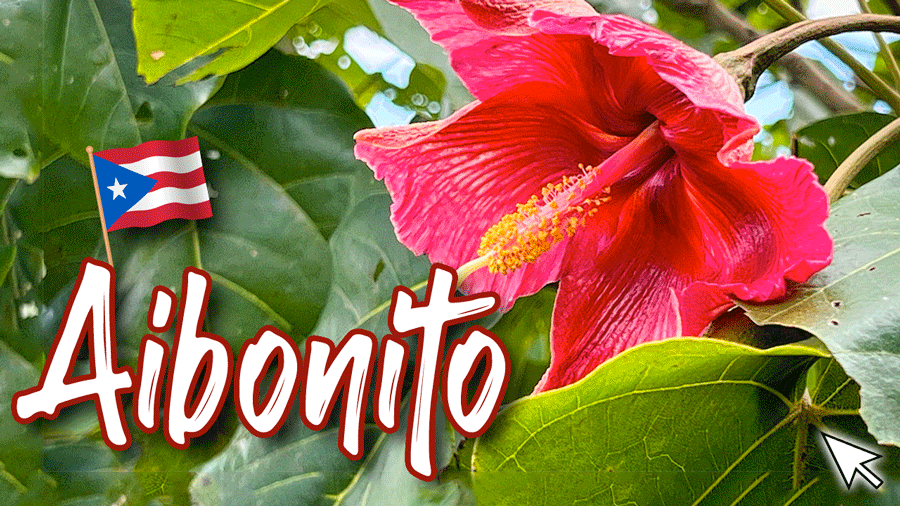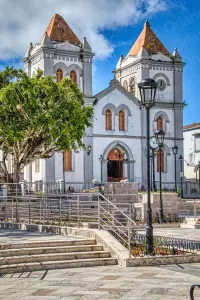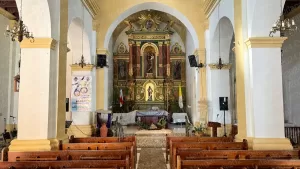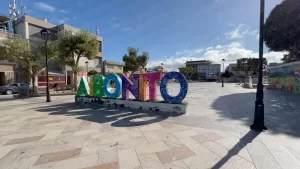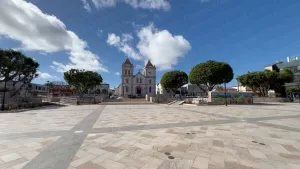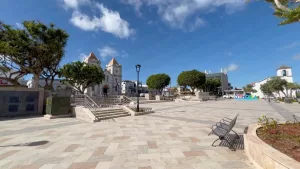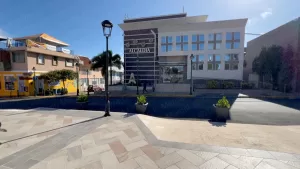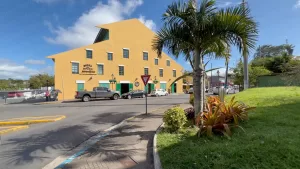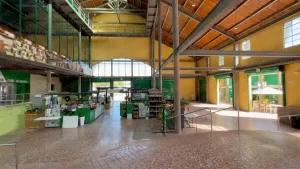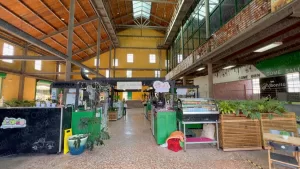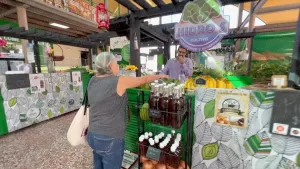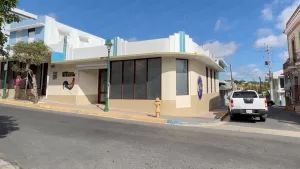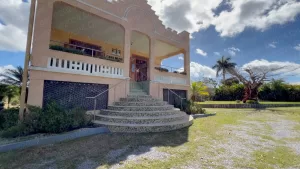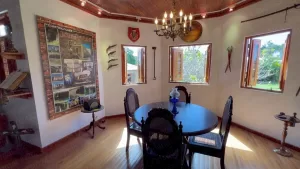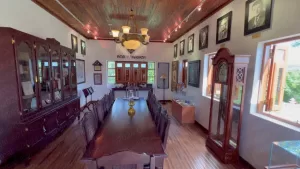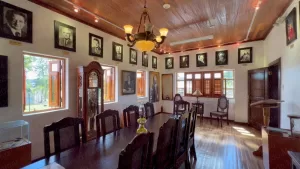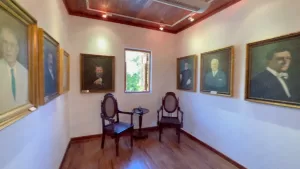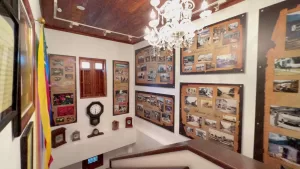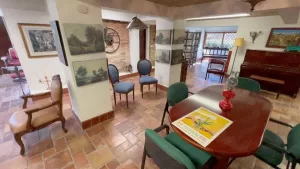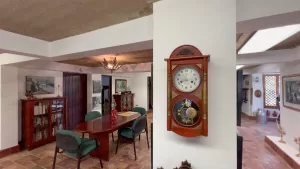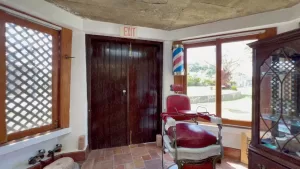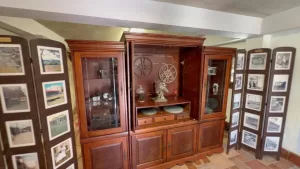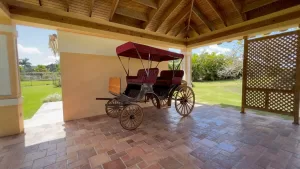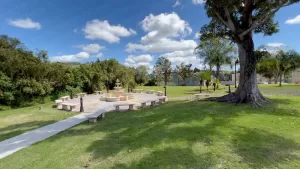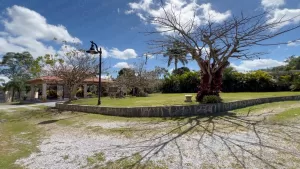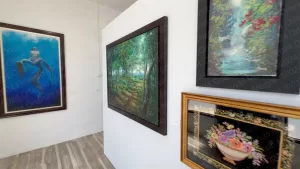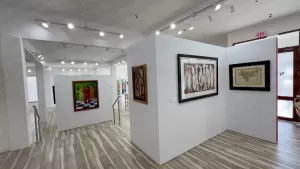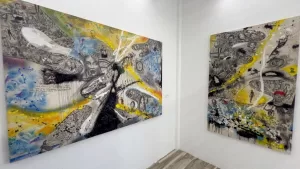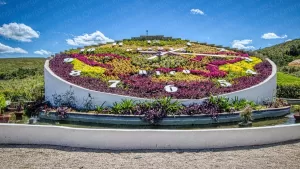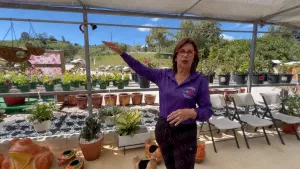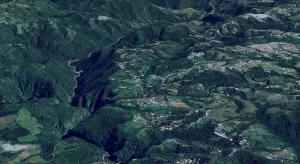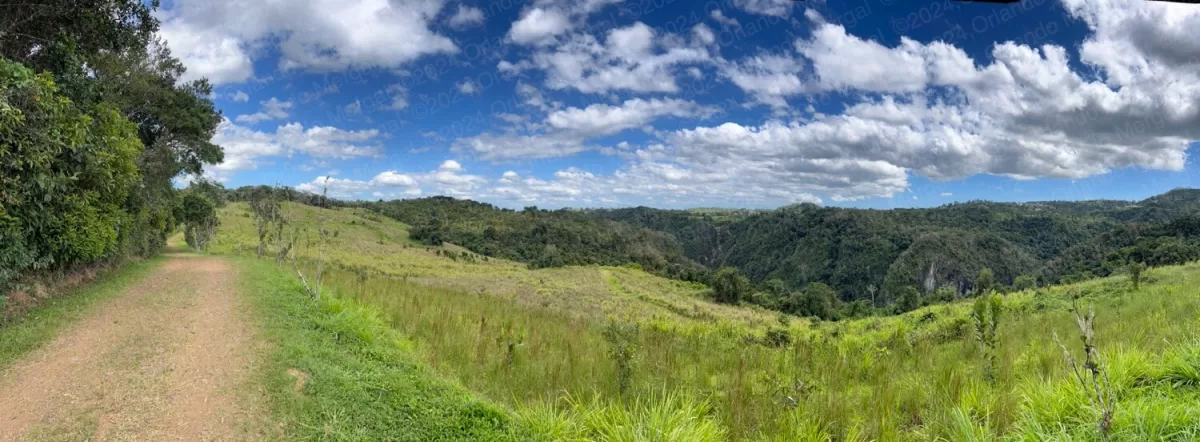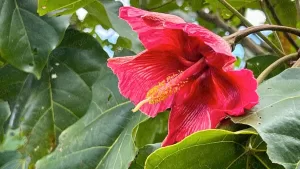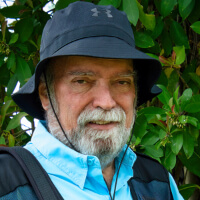This week my wife and I visited the beautiful town of Aibonito, Puerto Rico. We got to leave the noisy, stressful reality of urban living in the San Juan Metroplex to enjoy the peaceful beauty of Puerto Rico’s countryside; if only for a few hours.
We arrived in Aibonito, a little over 8:30, on the morning of February 26. It was a cool morning as far as Puerto Rico goes, with a temperature below 75°F. However, there was no fog. Normally, in this area of Puerto Rico, you get a thick fog in the morning that can hamper visibility, especially in Aibonito. But not last Monday. It was crystal clear.
Click on image to watch the video
When we arrived in Aibonito we parked on the north side of the town square. That’s when it hit me. The church is in the wrong place. Normally Catholic churches on the Island are on the east side of the town squares with their altars also pointing east. But, not the one in Aibonito. It points south. Why it was built that way, is way above my pay grade.
Aibonito has a beautiful Catholic temple call San José Parish, or Parroquia San José as the locals prefer to call it. It’s a beautiful Gothic style temple, with twin bell towers, that was built in 1825 and rebuilt between 1887 and 1897. That means that it’ll be celebrating its 200th birthday next year.
When we arrived in Aibonito our first stop was at the Catholic church. Experience has taught us that most Catholic churches on the Island open early in the morning to celebrate mass and then remain closed during most of the day. Why? Because they lack the personnel and the resources to have someone watching over the temples during the day. And since vandalism and theft have become an unfortunate reality, their only option is closing.
Fortunately, when we got to San Jose Parish it was open (well, most of it). As we entered we met several parishioners that were doing volunteer work. They welcomed us to the temple and gave us a brief tour. It’s a rather small temple that has that European feel. To the eye is looks well kept, but at the same time it gives you that “old” feeling. I loved it.
We also learned about the mishaps that the temple has endured during the series of storms and earthquakes that have affected Puerto Rico during the last six years. And, as if that weren’t enough, it was struck by lightning, which left it easternmost bell tower and the rear portion of the temple crippled.
That’s why I say that “most” of the temple was open, because the rear portion was cordoned off. In fact, the damage caused by the lightning strike was so severe, that they aren’t able to ring the church bells. Why? Because they fear that the bell’s vibrations could bring part of the temple down.
However, these are all technical considerations. You can’t tell by looking at the building. Sure, there are a few cracks here and there on the bell tower facade and the lightning rod was destroyed, but to the untrained eye it looks fine.
- Segundo Ruiz Belvis Square
(click on image to see it larger)
- Segundo Ruiz Belvis Square
(click on image to see it larger)
- Segundo Ruiz Belvis Square
(click on image to see it larger)
As we left San José Parish we went for a stroll through Aibonito’s main square, or plaza de recreo like they say in Spanish. Throughout the years this square has had four different names, but in its present incarnation it’s named after Segundo Ruiz Belvis. Segundo Ruiz Belvis was a Puerto Rican abolitionist, born on May 13, 1829, who also fought for Puerto Rico’s right to independence.
The square was recently remodeled and features a beautiful tile surface in tones of gray, tan and brown, adequate tree cover (given the damaged caused by recent hurricanes), public art and benches galore for people watching.
As we approached the northeast corner of the square we found Aibonito’s City Hall. It’s a modern style building covered in glass and painted in white with different gray accents. As we entered the building we met Mrs. Linnette Rivera, who manning the switchboard (or should I say “womanning“?) and in the middle of solving someone’s issue.
Her first reaction was to leave what she was doing and take care of us, but we told that we weren’t in any hurry. After ending her phone call she spent well over 30 minutes telling us about all the interesting places that we “needed” to see in Aibonito. She even gave us her personal cell phone number in case we got lost or needed further information.
Walking east along Gerónimo Martínez Street (that’s the street where we parked on the north side of the square) we made a slight left turn at Ignacio Colón Street and arrived at the Old Tobacco Factory. It’s a huge, recently restored building, painted in yellow, with white and green trims, that’s home to the Aibonito Sports Museum.
The Aibonito Sports Museum only opens on Saturdays, and —of course— we were there on a Monday. However, that’s not the only thing that this building has to offer. The restoration work that they did on this building is stunning, with wide open areas, small shops and a small farmer’s market in the middle.
- Farmer’s Market at Old Tobacco Factory
(click on image to see it larger)
- Farmer’s Market at Old Tobacco Factory
(click on image to see it larger)
- My wife couldn’t resist the avocados
(click on image to see it larger)
In fact, my wife and I bought an avocado, about the size of a large grapefruit, some “cilantrillo” (coriander) and lemons and whipped up the most scrumptious “pico de gallo” you can imagine for supper. But I digress.
As we left the Old Tobacco Factory we walked a couple of blocks west along road 14. There was a recently restored building, on the corner of road 14 and Padial Street that caught our attention. It has two giant roosters on the side and the windows are in frosted white glass. Since we couldn’t see inside we immediately concluded that it had to do with cockfighting. Cockfighting has been part of the Puerto Rican culture for centuries. Even with the recent prohibition by federal law, the practice continues.
In any case, we were wrong. In a few more paragraphs you’ll find out why.
After passing the building with the two roosters we walked another block west and turned left at the corner of road 14 and Federico Degetau Street. From there we walked about four blocks south to the Casa Museo Federico Degetau; Degetau Museum in the King’s English.
This is one place you must visit when you come to Aibonito. After all, Federico Degetau was Puerto Rico’s first resident commissioner between 1900 and 1905. And in case you’re unfamiliar with the term, a resident commissioner is a non-voting member of the United States House of Representatives elected by the people of Puerto Rico. Resident commissioners are the only members of congress that serve for a four year term.
But Degetau was much more than a simple politician. He was a philanthropist, lawyer, writer, author and painter who trained in Barcelona and at the Complutense University in Madrid.
- Federico Degetau House Museum
(click on image to see it larger)
- Federico Degetau House Museum
(click on image to see it larger)
- Federico Degetau House Museum
(click on image to see it larger)
- Federico Degetau House Museum
(click on image to see it larger)
- Federico Degetau House Museum
(click on image to see it larger)
- Federico Degetau House Museum
(click on image to see it larger)
- Federico Degetau House Museum
(click on image to see it larger)
- Federico Degetau House Museum
(click on image to see it larger)
- Federico Degetau House Museum
(click on image to see it larger)
- Federico Degetau House Museum
(click on image to see it larger)
- Federico Degetau House Museum
(click on image to see it larger)
- Federico Degetau House Museum
(click on image to see it larger)
The museum is filled to the brim with documents and memorabilia from the early 20th century, as well as other artifacts that have been donated by the local public. In fact, everything in the building is either obtained from other institutions, a replica or a donation. At one point this was a condemned structure that was almost demolished and turned into a hamburger joint.
Thank God that a group of concerned citizens that call themselves the “Patronato del Archivo Histórico de Aibonito”, in English the “Board of Trustees of the Aibonito Historical Archive”, took it upon themselves to save and restore the house and turn it into a museum. “Casa Museo Federico Degetau” is open Fridays and Saturdays only. Admittance is free but donations are encouraged.
And if the “Casa Museo Federico Degetau” is great, even greater are the “two Normas”. And who were they? Well, they were the two ladies that spent well over an hour with us and explained every corner of this wonderful place. Their names: Norma Maldonado and Norma Reyes.
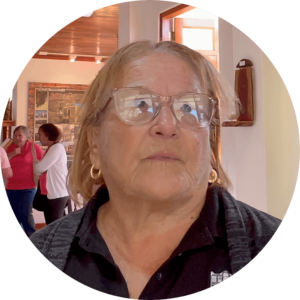
Norma Reyes
And, as it turns out (because the world is certainly a smaller place that we think) Norma Reyes turned out to be the widow of my friend Joe Esterás, who I met during my radio years at a local AM station in Old San Juan.
Their’s a third volunteer called Miguel Bisbal who’s just as knowledgeable, but we was taking care of another group that had just arrived from a different town.
After spending over an hour showing us the museum, the two Normas struck a conversation with us and ended up telling us about all the places that we “couldn’t miss” during our visit.
One of those places that we “couldn’t miss” was “Galería Vista Alegre”. Remember the place with the two roosters on the corner of road 14 and Padial Street? Well, that was it! It was an art gallery and we had no idea
We walked north to the corner of Federico Degetau and road 14, turned right, and returned to the gallery on the next corner.
Gallería Vista Alegre is a recently opened art gallery that holds a beautiful painting collection donated by Dr. Jorge Luis Sanchez Colón, a local dermatologist who was also a former president of the Government Board of University of Puerto Rico.
So why the roosters? Well, as it turns out, Sánchez grew up next to a cock fighting ring and “Vista Alegre” was the name of that ring.
When we got to the gallery we met with Mr. Antonio Sánchez, a very nice man who turned out to be doctor Sánchez’s brother. Admittance to the gallery is free.
- Galería Vista Alegre
(click on image to see it larger)
- Galería Vista Alegre
(click on image to see it larger)
- Galería Vista Alegre
(click on image to see it larger)
- Galería Vista Alegre
(click on image to see it larger)
The gallery is divided into two sections. One side has doctor Sanchez’s private collection and the other has paintings by local artists.
Once again, after going through the gallery, we struck a conversation with the museum attendant about Aibonito and its attractions. Come to think of it, everywhere we went in Aibonito we met with happy outgoing people that were eager to help.
It was way past noon and we still had several places on our to do list, so we after leaving “Galería Vista Alegre” we went straight to “El Jardín De Jeanny”, a local plant nursery where they recently installed a monumental floral clock. Of course, people don’t call it that. They simply call it “el reloj de flores”.
It’s all the rage and people from all over the Island go there to enjoy it.
When we got there we met with Mrs. Jeanny Ibarra, who was kind enough to give us all the details about the new clock as well as a private tour.
It all started with a trip to Niagara Falls, where Mrs. Ibarra and her husband saw a similar timepiece. This is certainly not the only monumental clock in Puerto Rico, but it’s probably the only one that works.
It’s a joint venture between Puerto Rico and Mexico and there are no federal, state or municipal fund involved. It’s a 100% private concern.
Mrs. Ibarra was quick to point out that the clock was tailor made to blend in with the area’s mountains. That’s why it’s slanted lower than other clocks built by the same company.
It’s also alive! Well, at least the flowers are. It has over 5,000 plants that are actually “planted in the ground” and fed with a drip system controlled by hygrometers. That means that the system know when the soil is moist or dry and applies water accordingly.
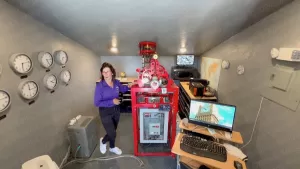
The “belly of the beast”. We even got to see the mechanisms and computers that “make it tick”. |
(click on image to see it larger)
At the heart of the system is a computer-controlled mechanism that actuates the clock, keeps it in perfect time via the Internet and rings the bells every fifteen minutes and on the hour. It also plays several tunes that vary by the time of day and day of the week.
There are several other amenities at the “reloj de flores”, like an artesanal fair on weekends, food, coffee, soft drinks and artisanal beverage called “maví” that goes all the way back to the Island’s Taíno roots. It’s an acquired taste, but I personally love it.
Alcoholic beverages are not served in keeping with the family oriented vibe.
Admittance to the “reloj de flores” is not free. After all, it’s a private venture, so someone has to pay the piper. However, the price is only five dollars for adults, children under 12 are free and there are special rates for groups and seniors. This covers a detailed tour of the clock as well as a sneak peak of the mechanism that makes it all work. All in all, you’ll spend about an hour at the “reloj de flores”.
Of course, if you’re a local, you’ll be able to buy plants at the nursery. But, if you’re a tourist, they’ll be taken away by the Federal Department of Agriculture at the airport.
There are two places that I’m going to mention in the remainder of this article. One of them requieres a guided tour that you can arrange through city hall and the other requires that you visit Puerto Rico in July.
First we’ll talk about San Cristóbal Canyon, or “El Cañón de San Cristóbal”, as it’s commonly known in Puerto Rico.
The San Cristóbal Canyon is the deepest land canyon in the Caribbean, and it’s home to some of the tallest waterfalls in Puerto Rico.
According to Wikipedia, at its tallest point, the San Cristóbal Canyon has a vertical drop of over 800 feet and a length of 6½ miles. It was carved by the Usabón River and it has more than 696 species of flora and 144 species of fauna.
I walked all the way to the bottom of San Cristóbal Canyon about 25 years ago. What I didn’t realize at the time was that the same 800 feet down were the 800 feet that I’d have to climb on my way back. Needless to say, I was convinced that I’d die then and there. The heat was unbearable, I was panting beyond control and sweating profusely.
That was when I was a lot younger. Today I wouldn’t even try. Keep this in mind before signing up for this adventure.
We’re talking about rugged terrain, slippery surfaces and lots of humidity. Once you get to the bottom you get mixed feelings. On one hand it’s a beautiful place with lush vegetation and the tallest waterfalls in Puerto Rico. But on the other hand there used to be garbage and rusted cars. That’s right!!! For many years the municipality of Aibonito and other surrounding towns used the San Cristóbal Canyon as a landfill.
Thankfully, the Puerto Rico Conservation Trust took over the place and has since done everything within its reach to restore it to its original glory.
This time we planned to walk to an observation deck where you can see the canyon lengthwise and a huge waterfall at the end. But we reached a point where we could already see what were supposed to be the falls and the river bed was a little bit dry. Apparently, it hasn’t rained much in recent days and the falls show it.
So at a little more than halfway to the observation deck we decided to return to our car.
Oh, and one last thing. What’s with that red flower that’s on the video thumbnail? You didn’t think I’d forget? Did you? Is that an “hibiscus”? Nope!!! And it isn’t an “amapola” either. It’s called a “flor de maga” or (maga flower) and it’s Puerto Rico’s state flower! And just so you know, it doesn’t come from a plant or bush. It actually comes from the “maga tree” and we ran into one on our way to San Cristóbal Canyon.
And what about that other attraction that you can only see in July? Well, it’s called the “Aibonito Flower Festival” or “El Festival De Las Flores De Aibonito” that draws thousands of tourists from all over the Island every month of July.
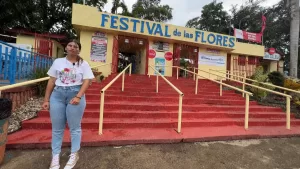
Aibonito Flower Festival (Festival de las Flores de Aibonito)
(click on image to see it larger)
There’s a reason why Aibonito is called “El Jardín de Puerto Rico”, or “Puerto Rico’s Garden. Plant nurseries are simply everywhere. The cooler climate and fertile terrain certainly favor growing activities and the “Aibonito Flower Festival” showcases them.
My wife and I visited the flower festival last July and saved the pictures for this article. It’s a multi-date event with plant exhibits, seminars, music and Puerto Rican food galore.
So where can you find more information about this and other points of interest in Aibonito? Your best bet is at City Hall. Just call (787) 735‑8181.
When we left San Cristóbal Canyon it was almost 4:30 and the drive back to San Juan was a little over an hour. So we drove down to the neighboring town of Cayey, took PR-52 and followed it to San Juan. In any case, if you’re not a local, your best bet is to get the coordinates to your hotel and punch them into your GPS to find your way back.
And talking about San Juan, if you’re planning to visit the Old City, save yourself the hassle of traditional city tours. They’re expensive and you’ll be herded along with people that won’t necessarily share your interests.
Instead, order The Old San Juan Walking Tour. It’s packed with useful information about all the main attractions, as well as every GPS coordinate and two hours of exclusive online video. That way you’ll be able to —visit before you visit— and hit the ground running when you arrive in the Old City.
See you next time!
©2024,Orlando Mergal, MA
____________________
Bilingual Content Creator, Blogger, Podcaster,
Author, Photographer and New Media Expert
Tel. 787–750-0000, Mobile 787–306-1590

